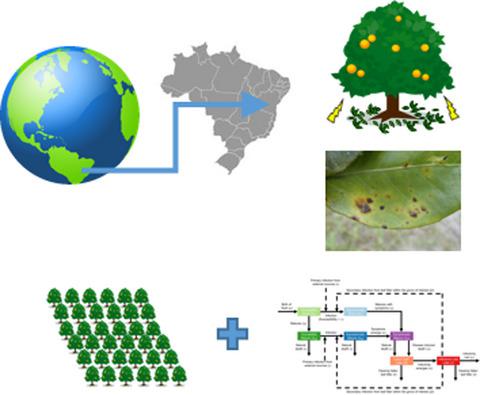当前位置:
X-MOL 学术
›
Plant Pathol.
›
论文详情
Our official English website, www.x-mol.net, welcomes your
feedback! (Note: you will need to create a separate account there.)
Spatiotemporal dynamics and modelling support the case for area‐wide management of citrus greasy spot in a Brazilian smallholder farming region
Plant Pathology ( IF 2.3 ) Pub Date : 2020-03-01 , DOI: 10.1111/ppa.13146 Francisco F. Laranjeira 1 , Suely X. B. Silva 2 , Rachel E. Murray‐Watson 3 , Ana C. F. Soares 4 , Hermes P. Santos‐Filho 1 , Nik J. Cunniffe 3
Plant Pathology ( IF 2.3 ) Pub Date : 2020-03-01 , DOI: 10.1111/ppa.13146 Francisco F. Laranjeira 1 , Suely X. B. Silva 2 , Rachel E. Murray‐Watson 3 , Ana C. F. Soares 4 , Hermes P. Santos‐Filho 1 , Nik J. Cunniffe 3
Affiliation

|
Citrus greasy spot (CGS), caused by Zasmidium citri, induces premature defoliation and yield loss in Citrus spp. The epidemiology of CGS is well understood in high humidity areas, but remains unaddressed in Brazil, despite differing climatic conditions and disease management practices. The spatiotemporal dynamics of CGS were characterized in the Recôncavo of Bahia (Brazil) at four hierarchical levels (quadrant, plant, grove, and region). A survey conducted in 19 municipalities found the disease to be present throughout the region with an incidence of 100% in groves and plants, and higher than 70% on leaves. Index of dispersion (D) values suggest the spatial pattern of units with symptoms lies between random and regular. This was confirmed by the parameters of the binary power law for plants and their quadrants (log[A] < 0 and b < 1). No consistent differences were observed in the disease incidence at different plant heights. We introduce a compartmental model synthesizing CGS epidemiology. The collected data allow such a model to be parameterized, albeit with some ambiguity over the proportion of new infections that result from inoculum produced within the grove versus external sources of infection. By extending the model to include two populations of growers—those who control and those who do not—coupled by airborne inoculum, we investigate likely performance of cultural controls accessible to citrus growers in northeastern Brazil. The results show that control via removal of fallen leaves can be very effective. However, successful control is likely to require area‐wide strategies in which a large proportion of growers actively manage disease.
中文翻译:

时空动力学和模型模拟为巴西小农户耕种地区柑桔油斑的区域管理提供了依据
Zasmidium citri引起的柑橘油腻斑点(CGS)会引起柑橘属植物过早的脱叶和产量损失。在高湿度地区,CGS的流行病学已广为人知,但在巴西,尽管气候条件和疾病管理方法不同,但仍未解决。CGS的时空动态在巴伊亚州的Recôncavo(巴西)中以四个等级(象限,植物,树丛和地区)进行了表征。在19个城市中进行的一项调查发现,该病在整个地区都存在,在树林和植物中的发病率为100%,在叶子上的发病率高于70%。分散指数(D)值表明出现症状的单位的空间格局介于随机和规则之间。植物及其象限的二进制幂定律的参数(log [ A ] <0和b <1)。在不同植物高度上,在发病率方面未观察到一致的差异。我们介绍了合成CGS流行病学的分类模型。收集的数据允许对这种模型进行参数化,尽管在树丛中产生的接种物与外部感染源相比,新感染的比例有些含糊。通过将模型扩展到包括两个种植者种群(控制者和不控制者),再加上空气传播接种物,我们调查了巴西东北部柑桔种植者可获得的文化控制的可能表现。结果表明,通过去除落叶来控制可能非常有效。但是,成功的控制可能需要采用区域策略,其中大部分种植者都积极控制疾病。
更新日期:2020-03-01
中文翻译:

时空动力学和模型模拟为巴西小农户耕种地区柑桔油斑的区域管理提供了依据
Zasmidium citri引起的柑橘油腻斑点(CGS)会引起柑橘属植物过早的脱叶和产量损失。在高湿度地区,CGS的流行病学已广为人知,但在巴西,尽管气候条件和疾病管理方法不同,但仍未解决。CGS的时空动态在巴伊亚州的Recôncavo(巴西)中以四个等级(象限,植物,树丛和地区)进行了表征。在19个城市中进行的一项调查发现,该病在整个地区都存在,在树林和植物中的发病率为100%,在叶子上的发病率高于70%。分散指数(D)值表明出现症状的单位的空间格局介于随机和规则之间。植物及其象限的二进制幂定律的参数(log [ A ] <0和b <1)。在不同植物高度上,在发病率方面未观察到一致的差异。我们介绍了合成CGS流行病学的分类模型。收集的数据允许对这种模型进行参数化,尽管在树丛中产生的接种物与外部感染源相比,新感染的比例有些含糊。通过将模型扩展到包括两个种植者种群(控制者和不控制者),再加上空气传播接种物,我们调查了巴西东北部柑桔种植者可获得的文化控制的可能表现。结果表明,通过去除落叶来控制可能非常有效。但是,成功的控制可能需要采用区域策略,其中大部分种植者都积极控制疾病。










































 京公网安备 11010802027423号
京公网安备 11010802027423号